Yakovlev Yak-1b
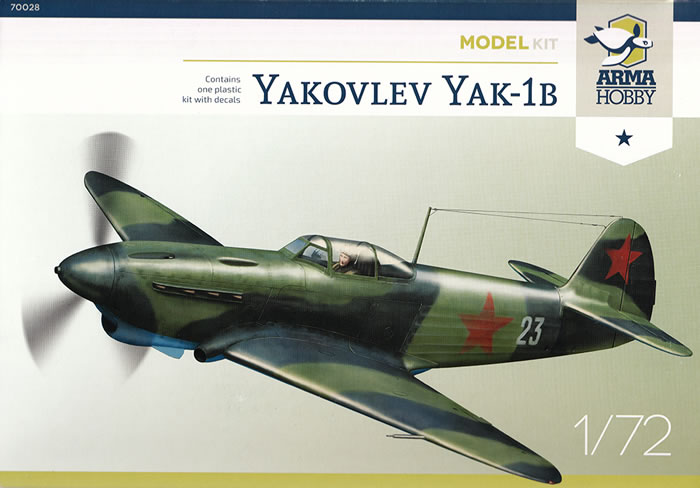
Arma Hobby, 1/72 scale
S
u m m a r y : |
Description and Item No.: |
Arma Hobby Kit No. 70028 - Yakovlev Yak-1b |
Contents and Media: |
44 parts in grey plastic, two parts in clear plastic; markings for three aircraft;. |
Price: |
€9.50 plus shipping available online at Arma Hobby
£10.30 EU Price (£8.58 Export Price) Plus Shipping at Hannants
and hobby retailers worldwide |
Scale: |
1/72 |
Review Type: |
First Look |
Advantages: |
Lovely fine and convincing surface textures; excellent moulding quality; high level of detail; thoughtful parts breakdown; locating pins to aid alignment and assembly; high quality packaging. |
Disadvantages: |
One-piece canopy; end-opening box. |
Recommendation: |
This is a very nice, well detailed but simple little kit. The Arma Hobby Yak-1b kit ticks all the right boxes, a great choice of schemes covering a range of schemes used in Polish and Russian service. |
Reviewed by David Couche

The Yakovlev Yak-1 was a World War II Soviet fighter aircraft. Production began in early 1940. It was a single-seat monoplane with a composite structure and wooden wings. 8700 built 41800 b versions.
The Yak-1 was a manoeuvrable, fast and competitive aircraft. The composite-wooden structure made it easy to maintain, and the engine proved to be reliable. It formed an essential basis for subsequent developments from the Yakovlev bureau. It was the founder of a family of aircraft, with some 43,000 being built. As a reward, designer Alexander Yakovlev was awarded the Order of Lenin– the highest decoration bestowed by the Soviet Union – a 100,000 rouble prize, plus a Zis motor car.
Prior to World War II, Yakovlev was best known for building light sports aircraft. His Yak-4 light bomber impressed the Soviet government enough to order the OKB to design a new fighter with a Klimov M-106 V-12 liquid-cooled engine. Formal specifications, which were released on 29 July 1939, called for two prototypes – I-26-1 with a top speed of 620 km/h (385 mph) at 6,000 m (16,685 ft), combat range of 600 km (375 mi), a climb to 10,000 m (32,808 ft) of under 11 minutes, and armament of 2 × 7.62 mm ShKAS machine guns and 1 × 12.7 mm (0.5 in) Berezin BS heavy machine gun, and I-26-2 with a turbocharged M-106 engine with a top speed of 650 km/h (404 mph) at 10,000 m (32,808 ft) and armament of 2 × 7.62 mm (.3 in) ShKAS machine guns. The design took full advantage of Yakovlev OKB's experience with sports aircraft and promised agility as well as high top speed. Since the M-106 was delayed, the design was changed to incorporate the Klimov M-105P V-12 engine, with a 20 mm (.8 in) ShVAK cannon in the "vee" of the engine block, in a motornaya pushka mount.
I-26-I first flew on 13 January 1940. The prototype suffered from oil overheating problems which were never completely resolved, resulting in 15 emergency landings during early testing. Technical issues with sub-assemblies provided by different suppliers raised the I-26-2's weight 400 kg (882 lb) above projected figures, which restricted the airframe to only 4.4 G, while overheating oil remained a problem. The many defects caused I-26-2 to fail government testing in 1940. Fortunately for Yakovlev, its competitors, I-200 (future Mikoyan-Gurevich MiG-3) and I-301 (future LaGG-3), also failed testing. Requested improvements were incorporated into I-26-3, which was delivered for testing on 13 October 1940. Although it passed on 9 December 1940, the aircraft was still very much unfinished, with unresolved engine problems.
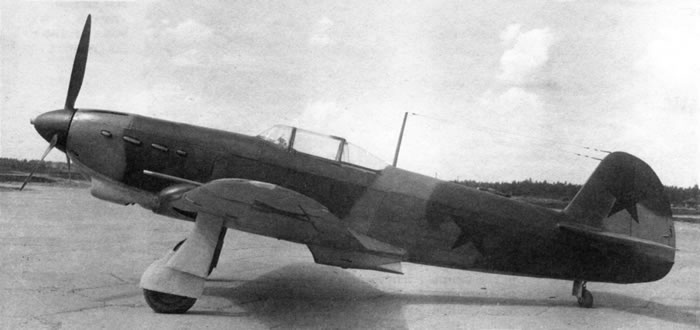
Troublesome and slow testing and development concerned Soviet officials, since I-26 was ordered into production under the name "Yak-1" on 19 February 1940, a mere month after I-26-1 made its maiden flight. The goal of this gamble was to reduce the lag time between the prototype and production aircraft. As backups, the I-200 and I-301 were also ordered into production. Although the Yak-1 was slower than the I-200 and less heavily armed than the I-301, it enjoyed the advantage of having been started earlier, which gave it a consistent lead in testing and development over its competitors. Due to the Axis invasion of the Soviet Union on 22 June 1941, development and implementation of several other upcoming promising designs, like the Polikarpov I-185, proved unfeasible. Yakovlev might have been Joseph Stalin's personal favourite, which may have been in the Yak-1's favour.
Simultaneous manufacturing and testing of a design that required as many improvements as I-26 wreaked havoc on the production lines. Almost 8,000 changes were made to the aircraft's blueprints by 1941, with an additional 7,000 implemented the following year, and 5,000 more changes coming in 1942. Production was further slowed by shortages of engines, propellers, radiators, wheels and cannons. Shortages of quality materials resulted in plywood being torn off the wings on several aircraft. To make matters worse, Factory No.292 which was the main manufacturer of Yak-1s was bombed on 23 June 1943 and burned to the ground. Amazingly, production resumed amid the ruins on 29 June. Due to loose tolerances, each aircraft was essentially unique, with workers performing the final assembly having the unenviable task of mating what often proved to be somewhat dissimilar components. For example, the left and right main landing gear could be of different lengths and different angles relative to the aircraft, which required adjusting their attachments to ensure an even stance for the completed aircraft. Parts were often not interchangeable between aircraft. Production of the Yak-1 ended in July 1944, with somewhere around 8,700 built of which 4,180 were “b” versions.
(Edited from Wikipedia)
Arma Hobby is a newer player in the modelling world, having released their first kit in 2014, with their early releases being all Polish aircraft but in the last couple of years they have gone more mainstream with Hurricanes and Yaks.
The kit comes in a fairly study end opening box containing a single grey injected moulded sprues containing 44 parts, a single clear sprue with 2 parts, a well printed instruction book and decals for 3 different aircraft.
Now let’s have a look in more detail:
Sprue A
This sprue contains 44 grey injected plastic parts. This has all you required to construct this model, making it simple to find and locate parts. The detail is very fine with a mix of recessed details along with some raised details. The detail moulding is some of the best I’ve seen in 1/72 and is par with the great Eduard surface detail. There is no real sign of flash and very minor mould seam marks to clean up.
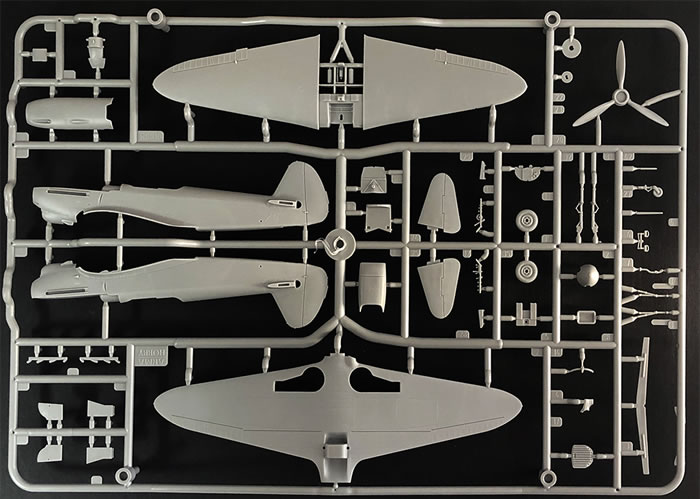
There is real nice surface detail for the different surfaces of the Yak-1b such as the metal panels, timber wing sections and the subtle fabric effect on the rear fuselage sections. The detail carries over to all the small parts as well. Be very careful in removing and working with some of the very fine cockpit parts. All that is needed to really bring this small model up isa set of etch seat belts.
Clear Sprue
Here we have the clear sprue of 2 parts. The canopy is a one piece canopy, beautifully clear, but without the ability to show the really nice cockpit to its best.
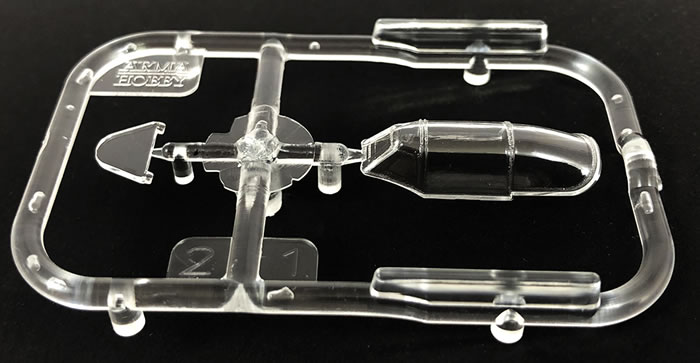
The clear armoured glass section behind the pilot is also supplied. All parts are very clear with nice detail where supplied.
Marking Options
The instructions for the kit are printed on glossy paper in a folded A4 format. The instructions are high quality detailed instructions, with copious colour call outs throughout, using the Hataka paint range and FS numbers, so there should be no issues using other brands of paint.
The decals appear to be in perfect register giving the options for 3 different aircraft. Included are a set of stencils and instrument panel decals, with a separate page in the instructions for their placement.
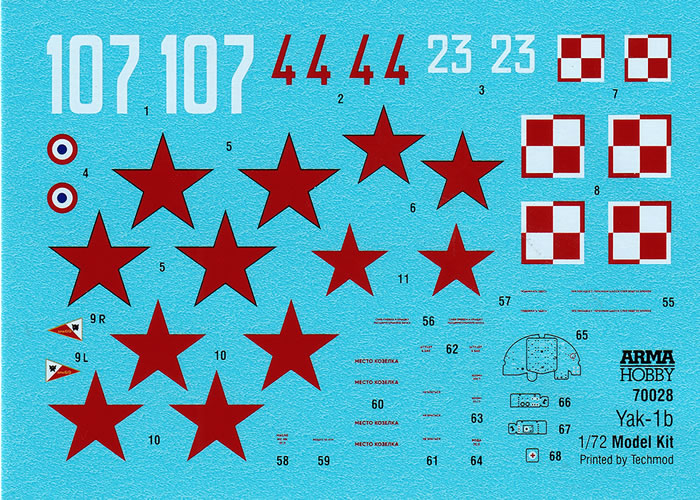
I have included a scan of the 3 aircraft profiles but briefly, they are;
-
Yak-1b, No 107, 1 Fighter Aviation Regiment, late 1945
-
Yak-1b, No 23, 73 GIAP, Sen Lt. Lydia Litvyak, Krasnyi Luch, July 1943
-
Yak-1b, No 44, GC 3 Normandie-Niémen, Lt. Marcel Albert, March 1943
This is a very nice, well detailed but simple little kit.
The Arma Hobby Yak-1b kit ticks all the right boxes, a great choice of schemes covering a range of schemes used in Polish and Russian service.
Please be aware that there is also an ‘Expert Set’ of this kit with photo-etch etc all included, which fellow reviewer, John Miller, did a build review on a couple of weeks ago.
I am really looking forward to building this very soon and will highly recommended it to my fellow modellers.
Thanks to Arma Hobby for the sample
Review and Images Text Copyright © 2019 by David Couche
Page Created 11 March, 2020
Last updated
11 March, 2020
Back to HyperScale Main Page
Back to Reviews Page |
Home
| What's New |
Features |
Gallery |
Reviews |
Reference |
Forum |
Search